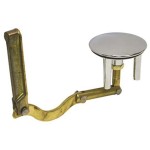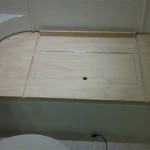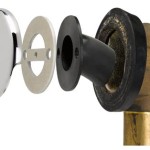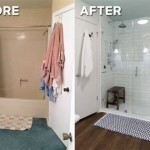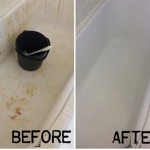How to Fix a Leaky Bathtub Faucet: Single Handle Delta Shower Faucet
A dripping bathtub faucet, particularly a single-handle Delta shower faucet, is a common household plumbing issue. This problem not only causes an annoying sound but also leads to water wastage, increasing water bills. Addressing the leak promptly is crucial to prevent further damage and conserve water. Diagnosing the cause of the leak and implementing the appropriate repair are the key steps in resolving this issue. This article provides a comprehensive guide on how to fix a leaky single-handle Delta shower faucet.
Identifying the Cause of the Leak
Before attempting any repairs, it is essential to determine the source of the leak. Leaks from a single-handle Delta shower faucet typically originate from a few specific areas. The most common culprit is a worn-out or damaged cartridge. The cartridge is a central component within the faucet body that controls the flow and mixture of hot and cold water. Over time, mineral deposits can accumulate on the cartridge, causing it to degrade and fail to seal properly, leading to leaks. Another potential cause is worn-out O-rings and seals within the faucet assembly. These rubber or silicone rings provide a watertight seal between different components. Aging, exposure to chemicals in the water, and constant use can cause these seals to harden, crack, or erode, resulting in leaks.
Another possibility is a loose or damaged valve seat. The valve seat is the surface against which the cartridge or valve stem presses to stop the flow of water. If the valve seat is corroded, cracked, or misaligned, it will not create a proper seal, allowing water to escape. Lastly, the faucet handle itself could be the source of the leak. A loose or damaged handle connection can allow water to seep out around the handle base. Carefully inspecting all of these potential sources of the leak will allow for accurate diagnosis and targeted repair.
Gathering Necessary Tools and Materials
Once the source of the leak has been identified, it is vital to gather the necessary tools and materials before starting the repair. Having everything readily available will streamline the process and prevent unnecessary delays. Here is a list of essential tools and materials:
- New Delta Faucet Cartridge: Ensure the replacement cartridge is compatible with the specific model of the Delta faucet. The faucet model number is typically located on the faucet body or in the product documentation.
- Cartridge Puller (Optional): A cartridge puller is a specialized tool designed to remove stubborn cartridges without damaging the faucet body. While not always necessary, it can be invaluable if the cartridge is tightly lodged.
- Adjustable Wrench: An adjustable wrench is required to loosen and tighten various nuts and connections within the faucet assembly.
- Screwdrivers (Phillips and Flathead): Screwdrivers are necessary for removing screws that secure the handle, escutcheon plate, and other components.
- Allen Wrench Set: Some Delta faucets use Allen screws to secure the handle. An Allen wrench set will ensure the correct size wrench is available.
- Plumber's Grease or Silicone Grease: Plumber's grease or silicone grease is used to lubricate the new cartridge and O-rings, facilitating smooth installation and preventing future leaks.
- New O-rings (If Necessary): If the source of the leak is identified as worn-out O-rings, ensure the replacement O-rings are the correct size and material for the specific faucet.
- White Vinegar or Lime Remover: White vinegar or a commercial lime remover can be used to dissolve mineral deposits that may be affecting the faucet's performance.
- Clean Rags or Towels: Clean rags or towels are essential for cleaning up spills, drying components, and protecting surfaces.
- Flashlight: A flashlight will provide better visibility when working inside the faucet body.
- Bucket: A bucket is useful for catching any residual water that may drain from the faucet.
Having these tools and materials readily available will ensure a smooth and efficient repair process.
Step-by-Step Repair Procedure
Following a detailed step-by-step procedure is crucial for successfully repairing a leaky single-handle Delta shower faucet. Adhering to these steps will minimize the risk of damage and ensure a proper repair. Before starting any work, turn off the water supply to the shower. This is typically done by locating the shut-off valves for the hot and cold water lines leading to the shower. The shut-off valves are often located behind an access panel in the wall behind the shower or in the basement below the bathroom.
- Remove the Handle: Locate the set screw on the faucet handle. This screw is typically hidden under a cap or cover. Use the appropriate Allen wrench or screwdriver to loosen and remove the set screw. Once the set screw is removed, carefully pull the handle straight off the faucet body.
- Remove the Escutcheon Plate: The escutcheon plate is the decorative plate that covers the faucet valve. Some escutcheon plates can be unscrewed, while others are held in place by screws. Remove any screws securing the escutcheon plate and carefully pull it away from the wall.
- Remove the Retaining Clip or Nut: Underneath the escutcheon plate, there will be a retaining clip or nut that holds the cartridge in place. Use a screwdriver or adjustable wrench to remove the retaining clip or nut.
- Remove the Cartridge: Once the retaining clip or nut is removed, carefully pull the cartridge straight out of the faucet body. This may require some force, particularly if the cartridge is corroded or has mineral deposits. If the cartridge is difficult to remove, use a cartridge puller. Follow the instructions that come with the cartridge puller.
- Inspect the Cartridge and Valve Seat: Examine the old cartridge for signs of damage, such as cracks, wear, or mineral buildup. Also, inspect the valve seat inside the faucet body for corrosion or damage. If the valve seat is corroded, it can be cleaned with white vinegar or a lime remover. Use a small brush to scrub away any mineral deposits.
- Install the New Cartridge: Apply a thin coat of plumber's grease or silicone grease to the new cartridge and O-rings. This will facilitate smooth installation and prevent future leaks. Align the new cartridge with the slot or notch inside the faucet body and gently push it into place until it is fully seated.
- Reinstall the Retaining Clip or Nut: Reinstall the retaining clip or nut that holds the cartridge in place. Ensure the retaining clip or nut is securely tightened to prevent the cartridge from moving or leaking.
- Reinstall the Escutcheon Plate: Reinstall the escutcheon plate and secure it with the screws or by screwing it back into place.
- Reinstall the Handle: Align the handle with the valve stem and push it onto the faucet body. Reinstall the set screw and tighten it securely.
- Test the Faucet: Turn the water supply back on and check for leaks. Slowly turn the faucet handle on and off, checking for leaks around the handle, escutcheon plate, and spout. If any leaks are present, tighten the connections or repeat the steps above to ensure proper installation.
Carefully following these steps will ensure a successful repair of the leaky single-handle Delta shower faucet.
Addressing Specific Issues and Troubleshooting
While the above procedure covers the general steps for repairing a leaky single-handle Delta shower faucet, certain specific issues may require additional attention and troubleshooting. If the cartridge is particularly difficult to remove, using a cartridge puller, as mentioned earlier, is recommended. If a cartridge puller is unavailable, carefully try to grip the cartridge with pliers, protecting the faucet body with a cloth to avoid scratches, and gently twisting and pulling the cartridge simultaneously. If the valve seat is severely corroded or damaged, it may need to be replaced. Replacement valve seats can typically be purchased at hardware stores or plumbing supply stores. The old valve seat can be removed using a valve seat wrench or a specialized tool designed for this purpose.
Sometimes, even after replacing the cartridge, a small drip may persist. This can be due to a minor imperfection in the valve seat or a slight misalignment of the cartridge. In such cases, try slightly adjusting the position of the cartridge within the faucet body or applying a small amount of plumber's grease or silicone grease to the valve seat. If the leak originates from the handle base, tightening the handle connection or replacing the O-rings on the valve stem may resolve the issue. If the faucet is excessively old or corroded, it may be more cost-effective to replace the entire faucet assembly rather than attempting to repair individual components. Consider the age and condition of the faucet when deciding whether to repair or replace it.
If unsure about any aspect of the repair process, it is advisable to consult a qualified plumber. Attempting repairs without proper knowledge or experience can lead to further damage or injury. A plumber can accurately diagnose the problem and perform the necessary repairs safely and effectively.

How To Repair A Delta Tub Shower Valve

Fix A Leaky Delta Single Handle Shower Faucet For Under 2

How To Replace A Delta Cartridge And Fix Leaky Bathtub Faucet It Tutorials

How To Fix A Leaking Single Handle Bathtub Faucet Quick And Easy

Shower Faucet Repair Advocate Master Plumbing

How To Fix A Leaky Bathtub Faucet Delta Shower Cartridge L Replace

How To Fix A Leaky Single Handle Tub Shower Faucet Danco

My 1300 1400 Series Monitor Is Leaking From The Shower Head Or Spout When Handle Off What Do I Need

How To Fix A Leaky Shower Faucet Diy Family Handyman

How To Fix A Leaking Bathtub Faucet The Home Depot
Related Posts


